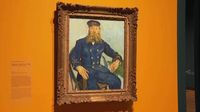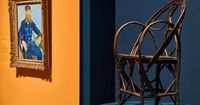The Van Gogh Museum in Amsterdam is inviting art lovers and history enthusiasts alike to experience a remarkable reunion this fall: the gathering of the Roulin family, immortalized in paint by Vincent van Gogh during one of the most pivotal periods of his career. The exhibition, titled "Van Gogh and the Roulins. Together Again at Last," brings together 14 of the 26 portraits the Dutch master created of postal worker Joseph Roulin, his wife, and their children between July 1888 and April 1889. This show, which opened on Friday, October 3, 2025, and will run through January 11, 2026, is more than just a display of iconic art—it’s a testament to friendship, creativity, and the unexpected ways in which ordinary people can become extraordinary muses.
According to the Associated Press, the Roulin family became central figures in Van Gogh’s life during his stay in Arles, a small town in the south of France. At the time, Van Gogh was struggling to make friends and find a sense of belonging. Joseph Roulin, a postal clerk known for his expansive beard and blue uniform adorned with gold buttons and trim, stepped into Van Gogh’s world not only as a model but also as a confidant and friend. The bond between the artist and the Roulins is palpable in every brushstroke, and now, for the first time in decades, their portraits are being reunited under one roof.
What sets this exhibition apart is not just the art on the walls, but the stories behind them. The Van Gogh Museum has gone to great lengths to source paintings of the Roulin family from museums around the world, assembling a collection that includes works by Van Gogh’s friend and fellow painter Paul Gauguin, as well as by Dutch Golden Age masters Rembrandt van Rijn and Frans Hals—artists who inspired Van Gogh during his time in Arles. The result is a show that not only highlights Van Gogh’s unique vision but also places it in the broader context of art history.
One of the most talked-about features of the exhibition is an unassuming yet historically significant object: the very armchair from Van Gogh’s studio in Arles, made of local willow from Provence. This simple chair, featured in one of the centerpiece portraits on loan from the Museum of Fine Arts in Boston, was discovered in the museum’s storerooms during preparations for the show. "As it turns out, we have this chair in our collection, but we have never shown it before," said Van Gogh Museum Director Emilie Gordenker, as reported by the Associated Press. "And it just shows you when you start to work on a topic—in this case, the Roulin family portraits—all kinds of things you might never have thought about before come up and it’s really exciting to rediscover, as it were, your own collection."
The chair, deemed too fragile to be sent to Boston for the exhibition’s earlier run at the Museum of Fine Arts, is now on display in Amsterdam for the first time. Its presence beside the portrait of Joseph Roulin offers visitors a tangible connection to Van Gogh’s world, grounding the art in the reality of everyday life in 19th-century Provence. Nienke Bakker, who curated the exhibition alongside Katie Hanson from the Boston Museum of Fine Arts, reflected on the emotional impact of this pairing: "It’s quite moving to have of course this fantastic portrait here, but also to be able to show the actual chair he was sitting in and to realize that it was quite a simple small chair."
The exhibition also features a life-size facade of the yellow house that Van Gogh used as his studio in Arles, transporting visitors into the heart of the artist’s creative environment. This immersive installation is more than a backdrop; it’s a reminder of the transformative power of place in Van Gogh’s work. The yellow house was not just a studio—it was a sanctuary where Van Gogh’s artistic vision flourished and where his friendship with the Roulin family deepened.
Van Gogh’s Arles period is often regarded as the zenith of his artistic output. "Many people consider his Arles period really his peak," Gordenker noted. "I’m not sure we totally agree with that, but it is definitely a moment when he turns a corner ... his power as an artist really comes out." During these months, Van Gogh’s creativity surged, resulting in a prolific output that included not only the Roulin portraits but also some of his most celebrated landscapes and still lifes.
But what made the Roulin family such compelling subjects for Van Gogh? According to Nienke Bakker, the answer lies in the artist’s own words. "He literally says painting people brings out the best in me, but also makes me feel part of humanity. So it’s a very important thing," Bakker explained. For Van Gogh, portraiture was more than a technical exercise; it was a way to connect with others and, perhaps, to find solace in the midst of personal struggles.
The relationship between Van Gogh and Joseph Roulin went beyond that of artist and model. In a letter to his brother Theo, Van Gogh described Roulin as a source of comfort and guidance: "While Roulin isn't exactly old enough to be like a father to me, all the same he has silent solemnities and tenderness for me like an old soldier would have for a young one." This sense of camaraderie is evident in the warmth and intimacy of the portraits, which capture not only physical likeness but also the emotional bonds that linked Van Gogh to the Roulin family.
After Van Gogh left Arles, the chair that had served as both a prop and a symbol of domestic life was passed on to the artist’s relatives and eventually made its way to the Van Gogh Museum. Its rediscovery and inclusion in the current exhibition is a testament to the enduring legacy of Van Gogh’s time in Arles and the importance of preserving even the most humble artifacts of artistic history.
The exhibition "Van Gogh and the Roulins. Together Again at Last" is more than a retrospective; it’s a celebration of the connections that sustain creativity and the everyday people who inspire greatness. As visitors walk through the galleries, surrounded by the faces of the Roulin family and the echoes of Van Gogh’s studio, they are invited to reflect on the power of art to bridge time, distance, and the boundaries between artist and subject. The show runs through January 11, 2026, offering a rare and moving glimpse into a chapter of art history where friendship, family, and creativity converged in the sunlit rooms of a yellow house in Provence.





